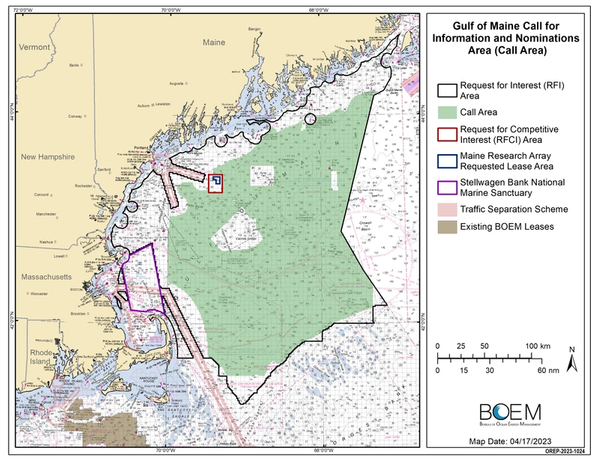
The U.S. Bureau of Ocean Energy Management (BOEM) on Tuesday invited public comment on possible commercial wind energy development in areas offshore Massachusetts, New Hampshire, and Maine.
BOEM said the call represented an early step in the commercial planning and leasing process in the Gulf fo Maine, and the first required by BOEM regulations.
“BOEM is committed to transparent, inclusive and data-driven processes, and public input is essential to helping us determine areas that may be suitable for offshore wind development in the Gulf of Maine,” said BOEM Director Elizabeth Klein. “We are still early in the planning and leasing process, and we look forward to the multiple future opportunities for engagement.”
BOEM will publish the Commercial Leasing for Wind Power Development on the Gulf of Maine Outer Continental Shelf (OCS) - Call for Information and Nominations in the Federal Register on Apr. 26, 2023, which will initiate a 45-day public comment period. BOEM will accept nominations and comments through 11:59 p.m. Eastern Time on Jun. 12, 2023.
After the public comment period closes, BOEM will review and analyze commercial nominations and public comments submitted in response to the Call. BOEM will also consider information from government and Tribal consultations and the Gulf of Maine Intergovernmental Renewable Energy Task Force to further evaluate the appropriateness of the Call Area for offshore wind energy development.
In August 2022, the Department of the Interior announced a “Request for Interest” (RFI) to gauge whether commercial interest existed in obtaining wind energy leases within an area in the Gulf of Maine comprising about 13.7 million acres. The final Call Area, published today, reduces the RFI area to 9.8 million acres, a nearly 30 percent reduction.
In the final Call Area, BOEM removed approximately 160,000 acres from future consideration to avoid Georges Bank.
"The Call Area remains broad to provide flexibility to minimize conflicts with other uses. BOEM will use a powerful spatial analytical tool, called an ecosystem-wide suitability model, developed in partnership with NCCOS, to help identify where conflicts may exist and inform decisions regarding the most appropriate Wind Energy Areas to meet the states’ and Biden-Harris administration’s offshore renewable energy goals," BOEM said.
Through the information exchanges on the draft Call Area, BOEM has identified four areas that BOEM specifically seeks public input on during this next phase of review, including: Lobster Management Area I, Platts Bank, Atlantic Large Whale Take Reduction Plan Restricted Areas, and Georges Bank (the immediately adjacent area along the southern boundary of the Call Area).
"This is not an exhaustive list; however, it represents the areas that were most commented on in the most recent public engagement. BOEM looks forward to receiving more information during the Call comment period regarding the suitability of these areas for potential renewable energy development," BOEM said.
BOEM will host its third Gulf of Maine Intergovernmental Renewable Energy Task Force meeting May 10-11, 2023, in Bangor, Maine.
The purpose of the meeting is to update Task Force members and the public on BOEM’s commercial and research offshore wind energy planning activities and to discuss next steps for the Gulf of Maine. The public is encouraged to attend this meeting, BOEM said.